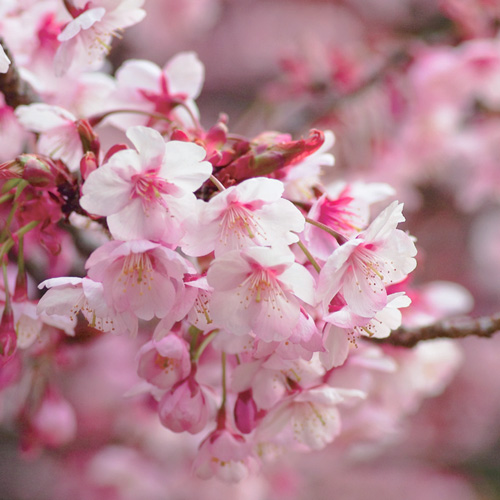by Faith Kitsunezaki
For centuries, the blooming of cherry blossoms (sakura) in Japan has held a near-magical significance, inspiring poetry, art, music, and kimono designs, while also symbolizing new beginnings. After the heavy grayness of a long winter, there is something about spring that warms the shoulders, lightens the step, brings a smile to the face, and makes one feel more alive. Everywhere you look, pink is in season: sakura bath products, sakura sweets, and sakura tea. It is a time for new students (shinnyusei) to enjoy time with their parents at school entrance ceremonies (nyugakushiki), a time for new employees (shinshakaijin) to join a company. Weddings are often scheduled for this time, with the floating sakura making a splendid background for photos of the bride (hanayome).
Weather forecasts show the progressive blooming from Okinawa in the south to Hokkaido in the north over the course of about a month (sakura zensen). It is during this time that people of all ages visit parks around the country, chasing the fragile beauty of the shortlived blossom. To see the spectacular wonder known as sakura in full bloom (mankai) is magnificent, a privilege once reserved only for royalty.
While there are several places in Tokyo where one can partake in the Japanese tradition of cherry blossom viewing (hanami), venture a bit further out for a truly unique experience. One of Saitama’s most historical parks, Gongendo-koen of Satte City, is currently celebrating its 80th sakura matsuri, or cherry blossom festival. But the history of viewing sakura in Gongendo extends back to Edo times, when there was once a river over which the members of the mikado (Japanese royal household) traveled to view the spectacular blossoms.
During the day, the fields of golden yellow rapeseed flowers (nanohana) in the old riverbeds provide an interesting contrast to the fragile pink sakura on the walkways above. Handwritten poems, prayers and wishes tied to branches sway in the whispering breezes that rustle the blossoms. Artists from near and far bring their brushes and paints to capture the exquisite sight on canvas.
At night, visitors can experience yet another Japanese tradition, yozakura. Lights illuminate the trees, providing a magical element in the cool evening air. Many couples take advantage of the romantic atmosphere to stroll along under the blossoms and stars.
Regardless of what time of the day or night they visit Gongendo-koen, hanami-goers are greeted with a hearty, “Irasshaimase!” along the path of festival stalls in the park below the sakura trees. Most of these stalls are run by colorful, outgoing men, many with tattoos and bleached hair, who are always eager to offer up a smile and a friendly comment with their fare. The enticing aromas of fast-selling takoyaki (octopus in fried batter balls served with sauce) and the equally popular okonomiyaki (a savory pancake) fill the air.
In addition to the food and flowers, children will enjoy visiting other stalls that house traditional festival games and even a chance to catch a goldfish. If you are fortunate, you may chance upon the ‘ame ojisan’ as he skillfully twists and pulls candy gum (amezaiku) on the end of a stick to create wonderfully colorful dolphins and unicorns amongst other shapes, all to the delight of passing children. His is a dying craft, one to treasure before it is forgotten.
But hanami isn’t just for families. Yells of, “Kanpai!” (cheers) resonate from groups of merrymakers dotted under the trees on picnic blankets in the custom of hanayoridango, a chance to let loose after a harsh winter and spend time with friends and workmates. These groups generally vary greatly in size and average age, with the one constant being that all those involved enjoy delicious foods and sake while floating pink petals come to rest on coats and hair.
So no matter your age or interests, venture out of Tokyo to Gogendo this spring, and walk the path once trod by royalty to view a truly historical hanami.











